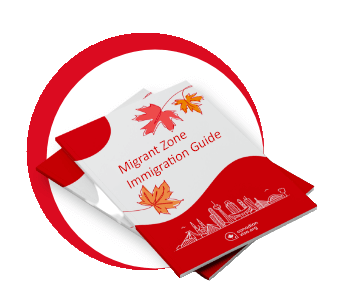
Are you an international student trying to decide between studying in Canada or the United States? With so many factors to consider, making the right choice can be challenging. The cost of living, tuition fees, lifestyle, and quality of education are just a few crucial factors that can influence your decision.
Both Canada and the USA have a lot to offer to international students, like study permits, top-quality educational institutions, and an open and welcoming society. Let’s take a closer look at the education system, cost of living, and lifestyle of both countries, helping you make an informed decision on the best country for your study abroad experience.
Studying Abroad

Studying abroad can be a life-changing experience, giving you a unique opportunity to explore new cultures, learn new skills, and broaden your horizons. Regarding international education, Canada and the United States are two of the most popular destinations for students from all over the world.
There are several reasons why studying in Canada and the United States appeals to international students. Firstly, both countries have a reputation for providing high-quality education, with top-ranked universities and colleges that are renowned globally.
Additionally, students studying in these countries have access to diverse programs, from science and technology subjects to arts and humanities. Moreover, both countries have vibrant and multicultural societies, welcoming international students with open arms.
Finally, studying in Canada and the United States can also provide students with valuable opportunities for personal growth and development, making it an attractive option for those seeking to enhance their career prospects and expand their cultural horizons. But which is better for you?
Academic Experience in Canada v USA
Canadian universities typically prioritize multiculturalism, and critical thinking, and may provide students with a second opportunity to succeed. In contrast, the American education system tends to be more competitive, strongly emphasizing sports and physical activities. The Organization for Economic Cooperation and Development (OECD) currently ranks Canada as the world's 7th best country for education, while the United States is ranked 8th.
Aside from university rankings, there are several other factors to consider when evaluating the academic experience of studying in Canada vs. the USA. One important factor is the availability of program options and flexibility in the curriculum. Both countries offer diverse programs, from traditional academic subjects to vocational courses, and many universities allow students to tailor their programs to their interests and career goals.
Another factor to consider is the availability of research opportunities. Canada and the USA are home to world-class research institutions, offering students the chance to engage in cutting-edge research projects and collaborate with renowned academics. However, the US has a more extensive research infrastructure and may offer more opportunities for students pursuing research-based careers.
Student-to-faculty ratio and class sizes are also essential factors to consider. Smaller class sizes and a lower student-to-faculty ratio can result in more personalized attention from professors, making it easier for students to ask questions and get help. Canadian universities generally tend to have smaller class sizes and a lower student-to-faculty ratio, providing students with more individualized attention.
Cost of Living and Quality of Life

There are significant differences in the cost of living and quality of life between Canada and the USA. When considering these factors, it's important to keep in mind that the cost of living will vary depending on where you choose to study.
If you're concerned about healthcare costs, Canada might be the better option. With its publicly funded healthcare system, students can expect significantly lower healthcare costs than in the USA. However, it's worth noting that healthcare costs can also vary depending on the region. While you won’t automatically qualify for public healthcare with a student visa as it depends on the province and the student’s medical system, often, their university will have a health insurance plan for those who do not qualify.
Regarding the cost of living, Canada and the USA have regions with high and low costs. Densely populated regions like Toronto and New York City will have a much higher cost of living than less populated regions like Guelph (Ontario) and Birmingham (Alabama). When deciding, you must consider your budget and the living expenses associated with the region you plan to study in.
Another factor to consider when thinking about the quality of life is the climate. The USA offers diverse climates, from warm and dry California to humid Florida. In contrast, Canada has a more uniform climate that is cold but has less variation in weather than the USA.
Ultimately, this comes down to personal preference. If you're someone who enjoys the variety of climates, the USA might be the better option for you.
Cost of Tuition
This is where Canada may win without a doubt against the US. Post-secondary education in the US is notoriously expensive.
It is important to note that these tuition costs are just an average, and it is possible to find more affordable or more expensive options in both countries.
The average cost of university tuition for an international undergraduate at a top university in the US is between $25,000 and $45,000 (KC Overseas Education) per year compared to Canadas’s $15,000 to $36,000 (TopUniversities) in US dollars. Keep in mind that both countries require international students to pay international student fees.
However, it is clear that the cost of higher education in the United States is generally much higher than in Canada, which is a significant factor to consider when deciding where to study.
Additionally, it is worth mentioning that many Canadian universities offer scholarships and bursaries specifically for international students, which can significantly reduce the cost of tuition.
In contrast, American universities tend to offer fewer scholarships and bursaries for international students, and those that are available may be highly competitive and difficult to obtain.
If the cost of tuition is a significant concern for you, studying in Canada may be a more financially feasible option. Check out Canada's cheapest and best universities.
Another point to consider is that many American universities require students to purchase health insurance, which can add thousands of dollars to the overall cost of education.
Canadian universities may offer health care to international students as part of their public health care system, which can save international students a significant amount of money.
Campus Culture and Social Life

University is not only about academics but also provides an opportunity for students to explore their interests, meet new people, and develop their social skills. The campus culture and social life are vital to the overall college experience. In this section, we will compare the campus culture and social life in Canada and the United States, discuss extracurricular activities and clubs, student diversity and inclusivity, and access to cultural events and festivals.
Campus Culture and Social Life in Canada and the United States
The campus culture and social life in Canada and the United States are quite similar, but there are a few differences.
In Canada, universities tend to be more laid back, and students can choose their courses and majors.
In contrast, the United States is known for its competitive college environment, and students have to work hard to maintain their grades and participate in extracurricular activities. In terms of social life, both countries have a vibrant campus culture, and students have many opportunities to socialize with their peers.
Extracurricular Activities and Clubs
Extracurricular activities and clubs are an essential part of campus culture and social life. Canada and the United States offer various clubs and activities for students to participate in. These include sports teams, cultural clubs, volunteer groups, and academic societies. Participating in extracurricular activities and clubs not only helps students meet new people but also provides them with valuable skills and experiences that can benefit their future careers.
Student Diversity and Inclusivity
Diversity and inclusivity are crucial aspects of campus culture and social life. Both Canada and the United States have a diverse student populations, and universities strive to create an inclusive environment for all students. In Canada, universities have implemented policies to promote diversity and inclusivity, such as affirmative action and multiculturalism. In the United States, universities have also made efforts to increase diversity and inclusivity, but challenges still need to be addressed.
Access to Cultural Events and Festivals
Cultural events and festivals are an excellent way for students to learn about different cultures and traditions. Canada and the United States have a rich cultural heritage, and universities organize various cultural events and festivals yearly. These include music and dance performances, film screenings, art exhibitions, and food festivals. Students can learn about different cultures, try new foods, and socialize with people from different backgrounds.
Learn more about student life in Canada.
Post-Graduation Opportunities

When it comes to employment opportunities, the United States has a much larger economy than Canada, with a population of 331.9 million people and a GDP of USD 23.32 trillion (2021). Comparatively, Canada has only 38.25 million people with a GDP of USD 1.9 trillion. Therefore, there are far more employment opportunities in the USA than in Canada.
Furthermore, the United States has more established companies and industries, which can create a more significant demand for job opportunities. That being said, there are several high-demand industries in Canada, such as healthcare and technology, where international students could find excellent job prospects.
Canada provides many employment opportunities for international students. With a growing economy and a focus on diversity and inclusivity, students can find various jobs in various industries. The country has a higher minimum wage than the United States, and many jobs offer healthcare and vacation time benefits. Students can also take advantage of the Canadian Post Graduation Work Permit, which allows them to work in Canada for up to three years after completing their studies.
However, it's important to note that job competition can be high, especially in larger cities. Students may need part-time or temporary positions to gain experience and build their resumes. Nevertheless, Canada's welcoming attitude towards immigrants and focus on work-life balance make it an attractive option for international students seeking post-graduation opportunities.
Post-Graduation Work Permits and Visa Requirements
Both Canada and the United States allow international students to work before and after the completion of their studies. However, the process and requirements differ significantly between the two countries.
Obtaining a student visa to Canada is relatively easier than in the USA. Regarding work permits, Canada has an open work permit policy that allows international students to work in jobs unrelated to their program of study. In contrast, the USA requires international students to have a job offer related to their studies program.
Canada offers international students who have studied in the country for more than two years the opportunity to pursue employment using the Canadian Post Graduation Work Permit (PGWP), which allows them to work in Canada for up to three years. In contrast, US international students can only work for three years after completing their program if they obtained degrees in the STEM (science, technology, engineering, and math) fields.
Prospects for Permanent Residency and Citizenship
One of the essential factors to consider as an international student is the prospects for permanent residency and citizenship after graduation. Canada has a much more welcoming immigration policy than the United States, making it a better option for post-study immigration.
Canada offers international students a direct pathway to permanent residency, unlike the United States, where many international students must transition to a temporary working visa before obtaining an employment-based immigrant visa. Canada has no caps on how many people can obtain permanent residency from any country. In contrast, the United States caps the number of employment-based immigrants at 140,000 people per year, subject to annual country limits. This makes it challenging for skilled immigrants, particularly those from populated countries such as India and China, to obtain permanent residency in the USA.
Pros and Cons of Studying in Canada and the United States
When deciding between Canada and the United States as a study destination, it's essential to consider the strengths and weaknesses of each country.
Canada offers an inclusive environment with affordable education and a direct pathway to permanent residency for international students. The country strongly focuses on research and innovation, and students can access various extracurricular activities and cultural events. However, competition for jobs can be high, and the weather can challenge some students.
In contrast, the United States has a larger economy and more extensive employment opportunities for international students. The country has diverse institutions and a reputation for academic excellence. However, education costs can be significantly higher than in Canada, and visa regulations can be complex and challenging.
Personal preferences and circumstances can play a significant role in the decision-making process. Location, climate, and cultural differences may impact a student's decision. Financial considerations such as the cost of living, tuition fees, and available scholarships should also be considered.
| Pros and Cons of Studying in Canada | |
|---|---|
| Pros | Cons |
| Affordable tuition fees compared to the US | Limited availability of top-ranked universities compared to the US |
| High-quality education system with internationally recognized degrees | Harsh winters and extreme weather conditions |
| Multicultural and inclusive society | Fewer options for extracurricular activities and campus culture compared to the US |
| Safety and security | |
| Access to universal healthcare | |
| Opportunities for post-graduation work and immigration | |
| Pros and Cons of Studying in US | |
|---|---|
| Pros | Cons |
| Prestigious and well-established universities with a wide range of academic programs | High tuition fees and student debt |
| Extensive options for extracurricular activities and campus culture | Challenging immigration policies and visa restrictions |
| Access to top-tier research facilities and resources | Safety concerns and crime rates in certain areas |
| Scholarship and funding opportunities | Limited access to universal healthcare |
| Vibrant and diverse cities | Higher living costs in metropolitan areas. |
How Can We Help You?

An RCIC, or Regulated Canadian Immigration Consultant, is a licensed professional who can provide immigration advice and assistance to those seeking to study, work, or immigrate to Canada. Regarding study visas, an RCIC can assess a student's eligibility, guide them through the application process, and ensure they meet the requirements for a study permit, such as proving acceptance into a Canadian educational institution, demonstrating sufficient funds, and having no criminal record.
FAQs
What are the Language Requirements for Studying in Canada?
Language requirements vary depending on the institution and program of study. Generally, most universities and colleges require proof of proficiency in English or French. For English proficiency, students may need to take the CELPIP or IELTS exams and meet the minimum score requirements.
Can International Students Work While Studying in Canada?
Yes, international students with a valid study permit can work on campus without a work permit. They may also be eligible to work off-campus for up to 40 hours per week (per the latest policy) during the academic year and full-time during scheduled breaks. After completing their studies, international students may be eligible for a post-graduation work permit, which allows them to work in Canada for up to three years.
What are the average living costs for international students in Canada?
Living costs in Canada vary depending on the city and lifestyle of the student. International students can expect to spend between CAD 10,000 to 15,000 per year on living expenses, including accommodation, food, transportation, and other miscellaneous expenses. It's important to research and budget accordingly to ensure you can afford to study and live comfortably in Canada.




